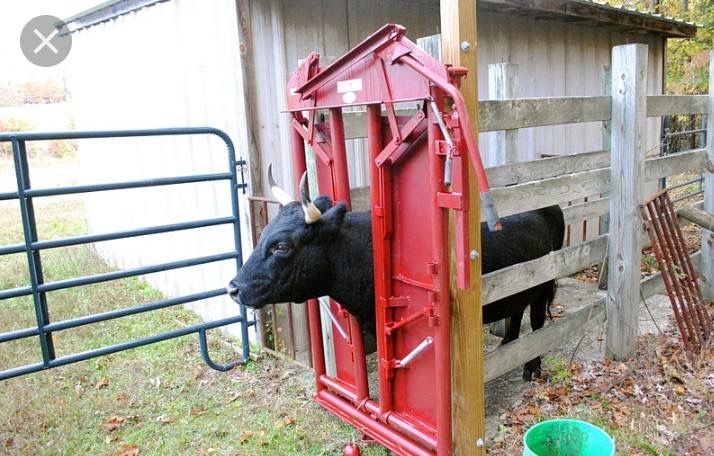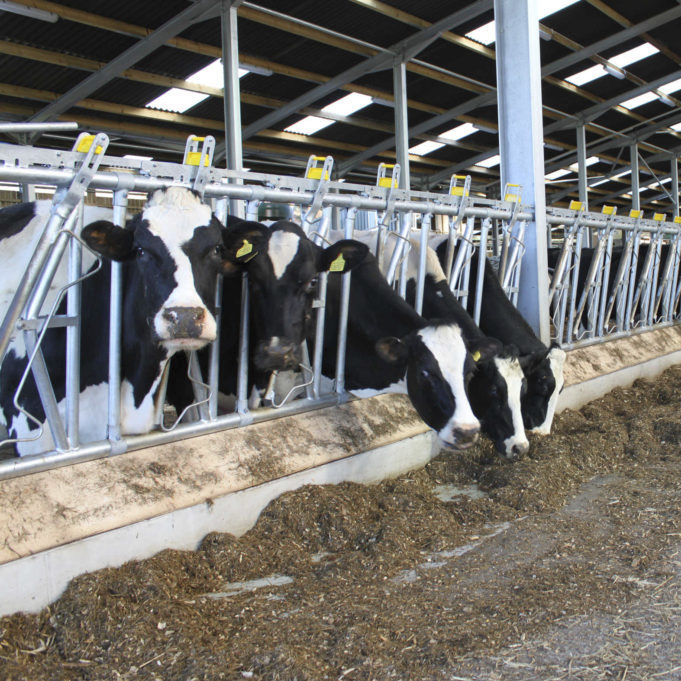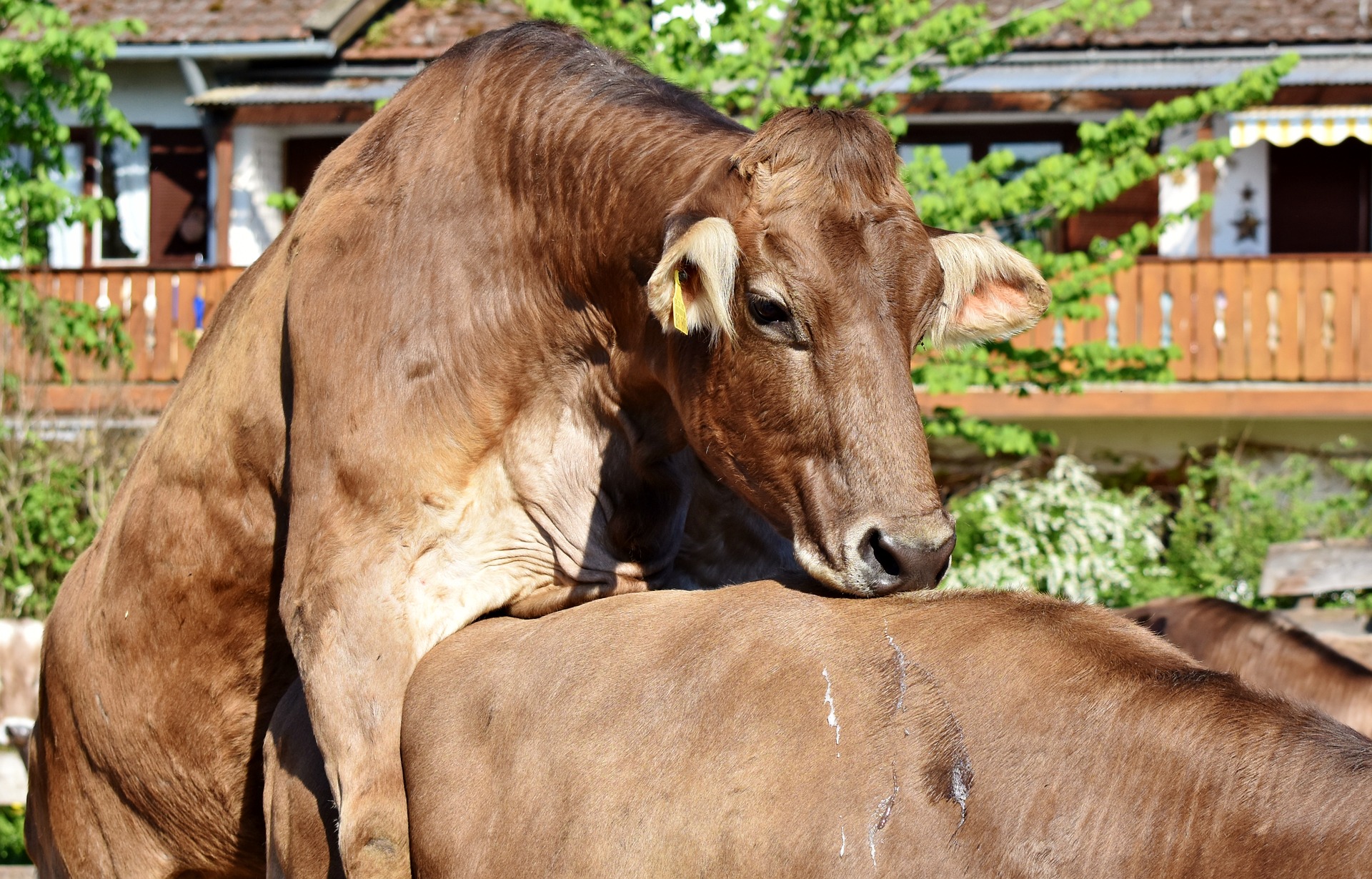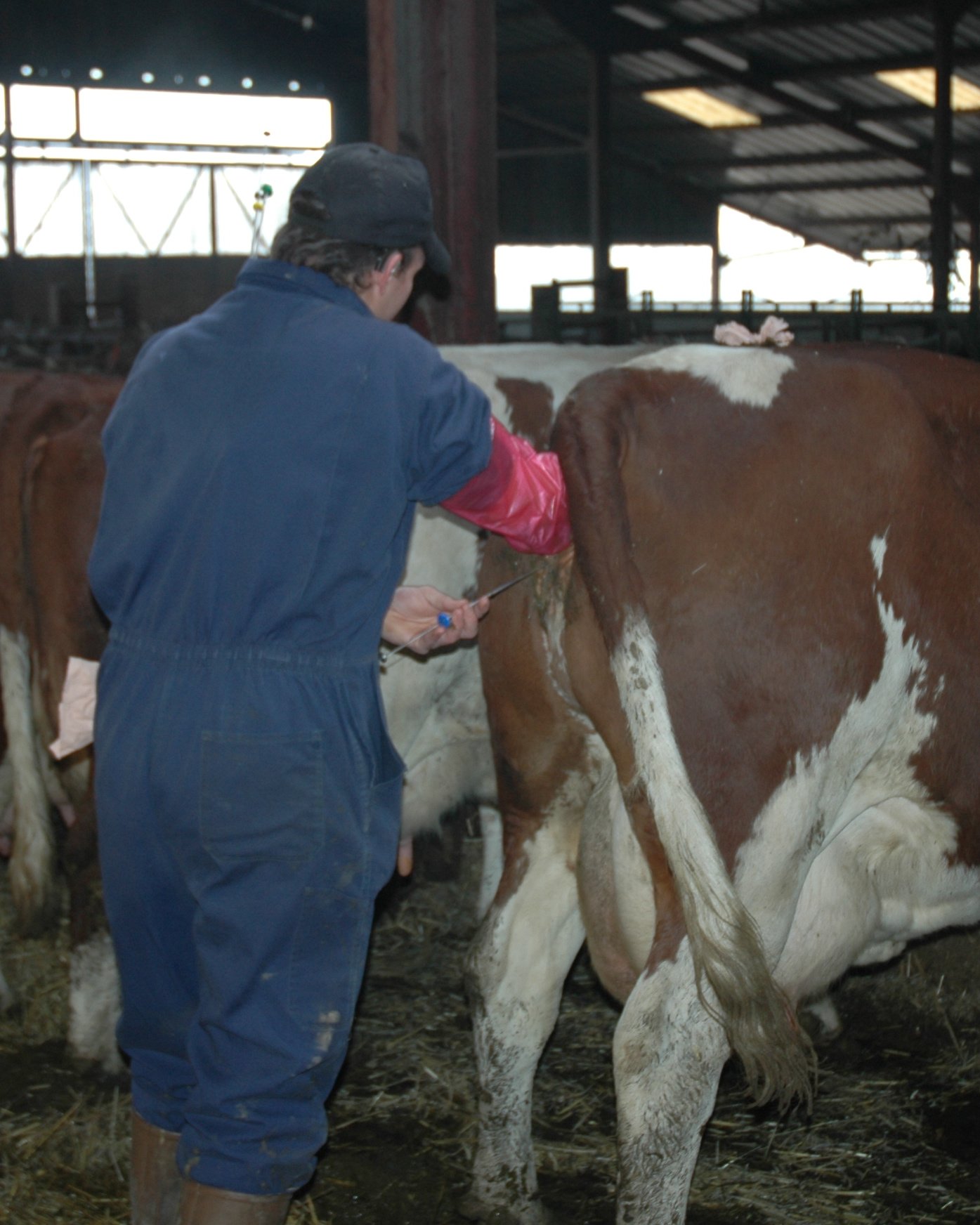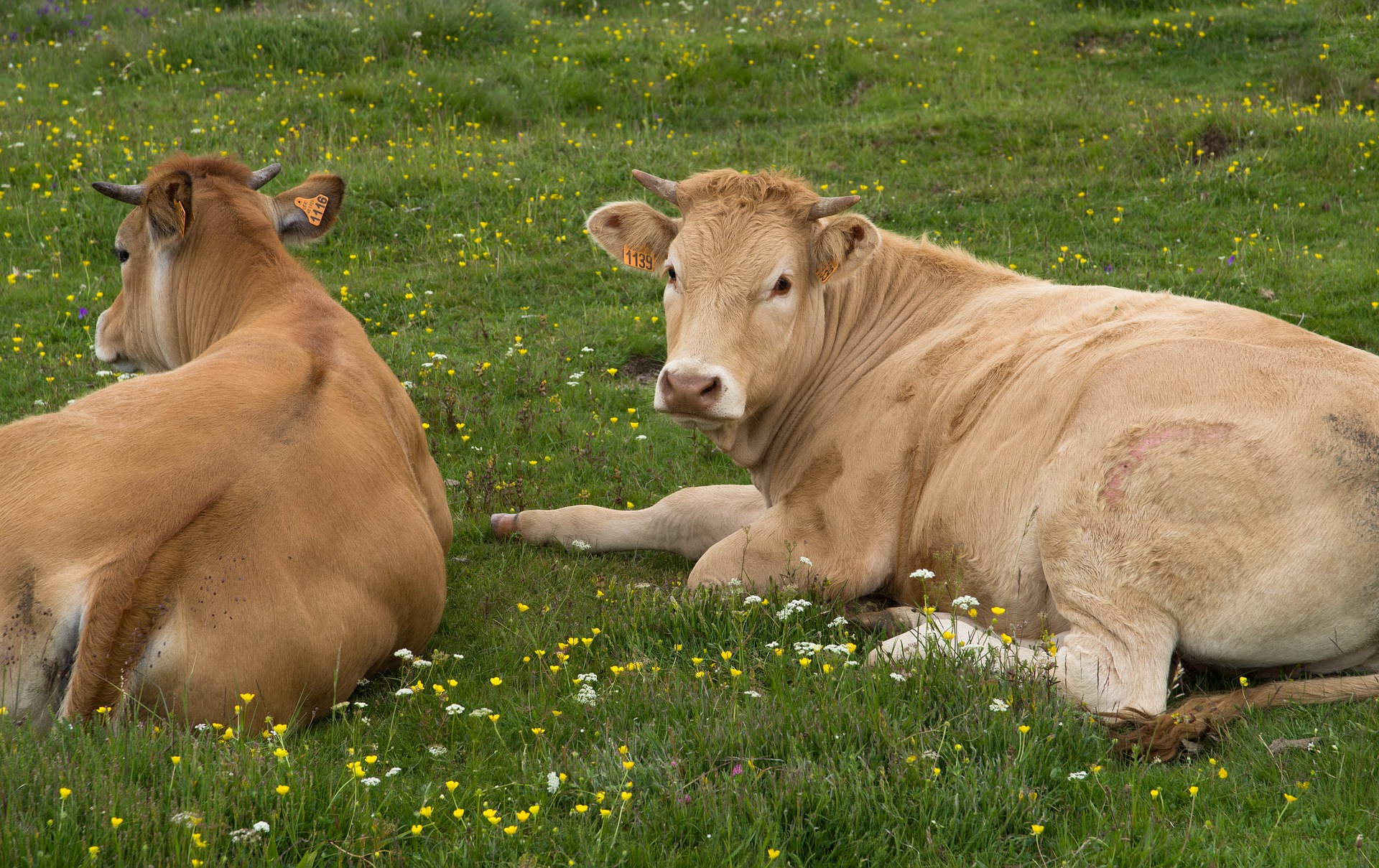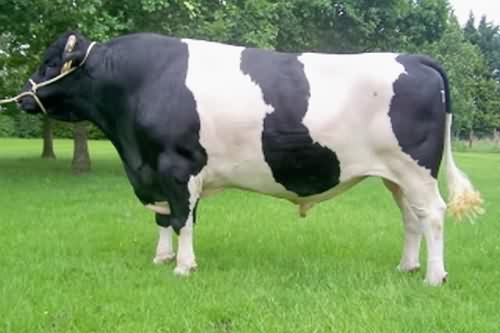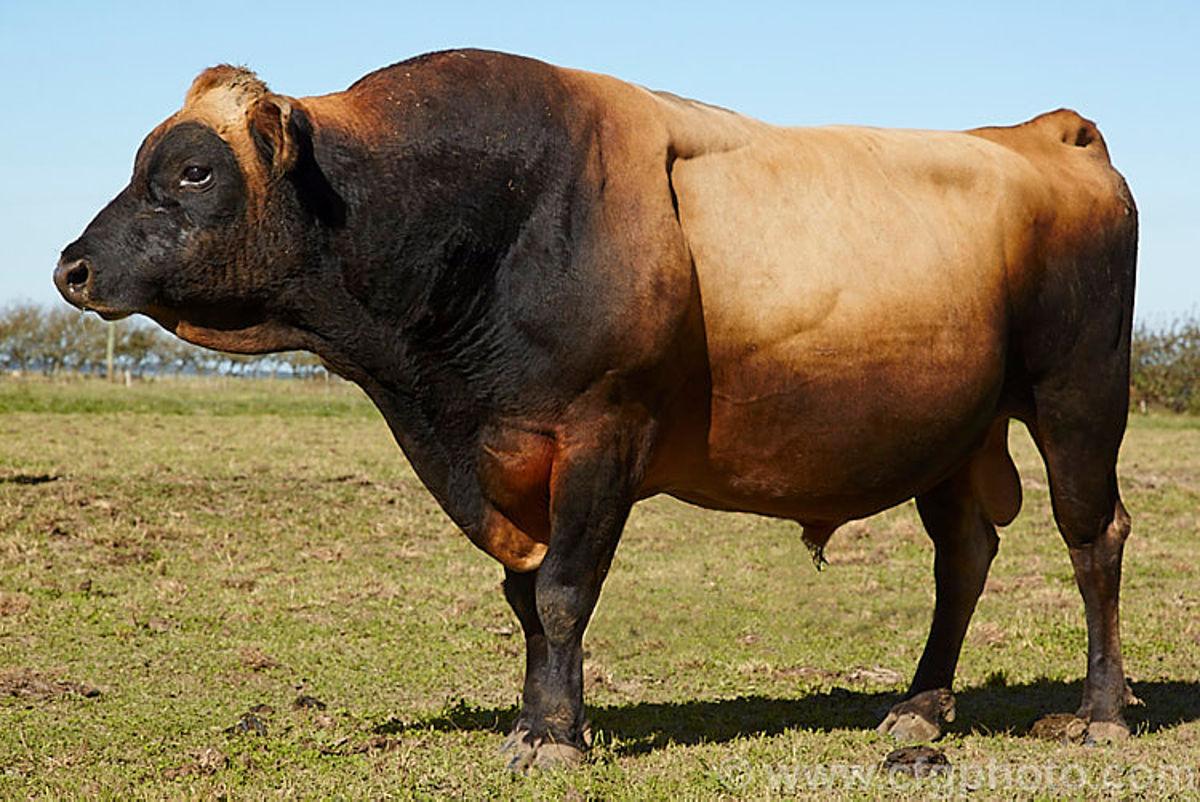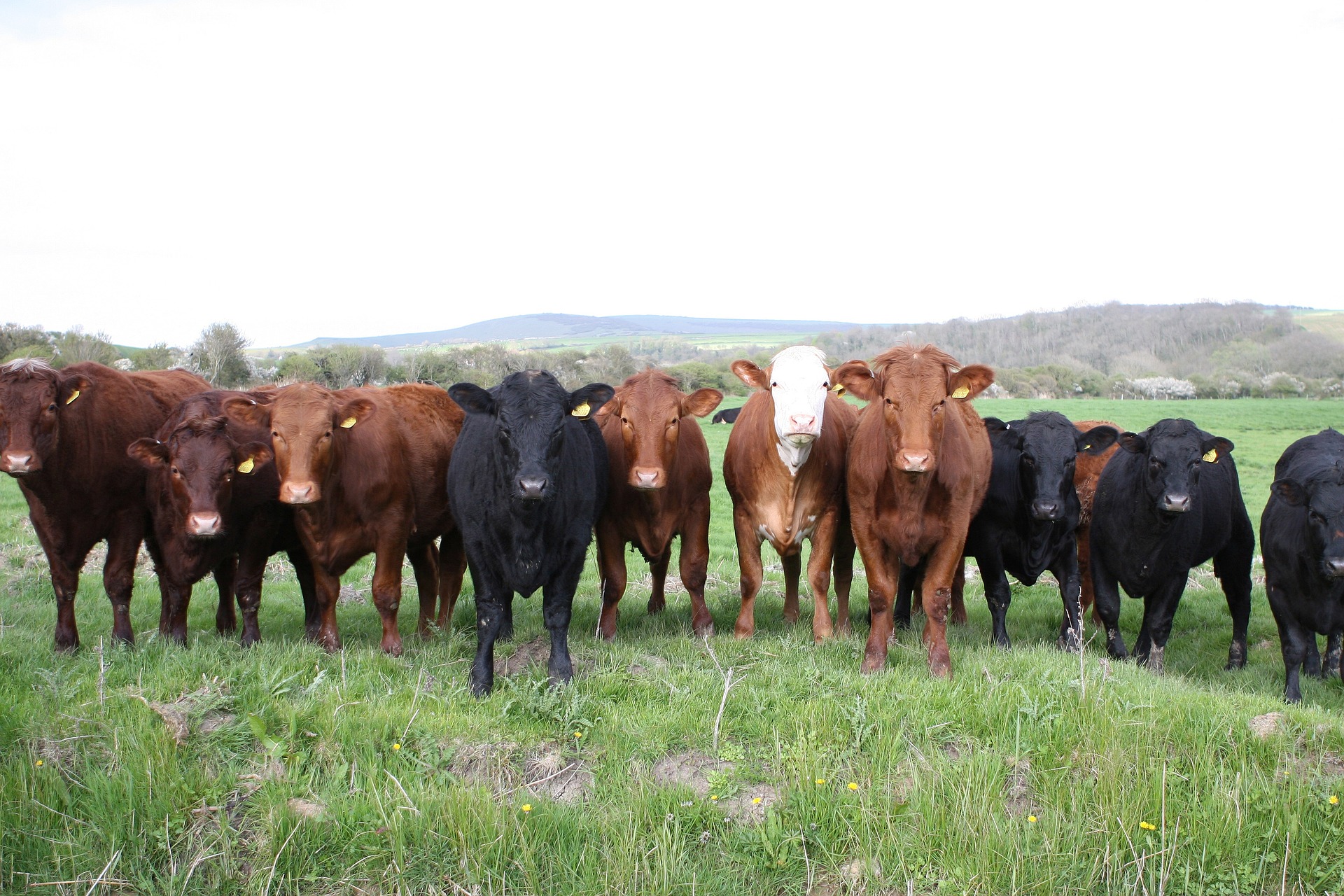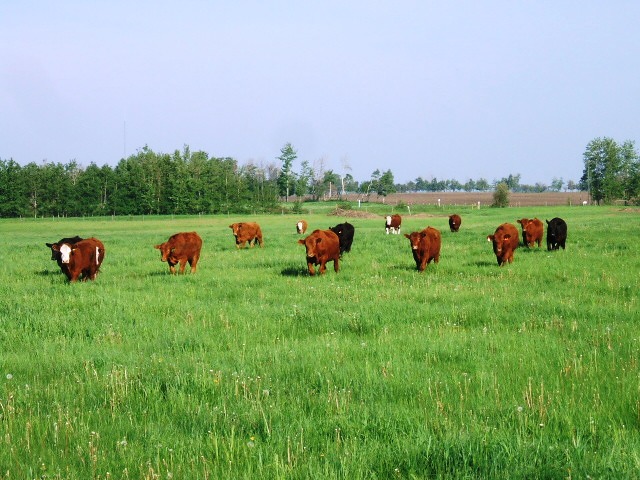VEGAN MYTHS ABOUT RUMINANTS
Are Cows Forcibly Impregnated?
One of the common animal rights myths associated with ruminants (especially cows) is that animals are forced, against their will, to become pregnant. Often this assumption is made in regards to artificial insemination. But, are cows really being “forcibly” impregnated?
***Note: Not all buttons are active links! See below for details.
In Brief
For the TL;DR readers.
The concept of “forcible impregnation” comes from not understanding how reproductive physiology or artificial insemination works. It’s based on the anthropomorphism of cows.
Cows cannot be forcibly impregnated because impregnation relies on their heat/estrus cycling. Artificial insemination (which is a veterinary medical procedure) can only be done when a cow (or heifer) is in heat. Trying at any other time is a waste of time and money. AI must also be gentle to be successful; being rough is an animal health and animal welfare issue no farmer wants to have.
Rape racks are vegan fantasy, nothing more. AI is done because dairy bulls are far more dangerous than most understand. Cows cannot do their own “family planning” and aren’t pets to be coddled and treated like a pet cat, dog, or hamster. Restraint, therefore, is important for both human and animal safety, and is not in any way, an act of animal cruelty.
Origins of the Myth
It’s difficult to point to who first coined the term “forced impregnation.” However, it undoubtedly came from one or more animal rights activists who wished to use a term that generated strong, negative emotions in educating the masses about how cattle farming actually works. It’s an easily-remembered term that sticks with you and has been repeated many, many times by all militant vegans, like these quoted below:
“Have you ever thought about forcibly impregnating your cat and then killing its children so that you can steal its milk? […] So few of us are exposed to how these animals are treated and killed. Ignorance is definitely one of the man driving forces behind speciesism…”
This quote is from Vegan Gains, a vegan YouTube influencer. And, this is from another YouTube vegan influencer, Joey Carbstrong in an Australian morning talk show (c. 2019):
Joey: “..and when she can’t produce milk anymore, she’s murdered for her body, okay? Her mother…”
Host 1: “And so, the rape is the insemination?”
Joey: “Well, it’s forible impregnation, isn’t it? If it was any… it’s, it’s the victim… if it was a human being we’d call it, what? What would we call it?”
Host 1 & 2: [after awkward moment of silence] “[But it’s] it’s not a human being, it’s a cow… “
Joey: “It’s forcible… it’s sexual abuse…”
To get down to the actual origin, regardless of who decided to coin it (as well as attribute it to rape), no doubt this came from non-farming, deeply-urbanized people who had the good intention of finding out how meat and milk get to their plates.
I imagine they were shocked to their core when they found out the truth. No doubt, too, that they felt outraged and angry upon realizing that animals are treated horrifically by the meat and dairy industries. So, they abstain from all animal products and also decide it’s their obligation to educate the masses who are, to paraphrase what VG said above, “definitely ignorant of the truth.”
These people believe that animals are much like us humans, with the same feelings, thoughts, actions, reactions, and wants of various freedoms of life. Anthropomorphism is the fuel that feeds the fire of the belief that no animals should be used or killed for food.
There are two primary aspects that explain why the term “forced impregnation” is such a strong belief among ARAs and militant abolitionist vegans:
- Human [mis]interpretation of bovine behaviour & psychology,
- Grossness and disgust over the “ugly realities” of how animals are raised for food.
More will be discussed on another page (see button below), however, it helps to provide an overview in the next block.
I have found, as have many “anti-vegans” like me, that almost all ARAs do not understand bovine behaviour and psychology. But, they don’t know it. Rather, they choose to remain ignorant of it. To them, all cows have the same emotions and feelings (though maybe not the intellect) as we do and that’s all that matters.
Hence the first layer of this myth is human [mis]interpretation of animal behaviour and psychology. It’s largely based on emotions and subjective attempts to feel and understand what those animals are going through and is not based on objective, rational, logical scientific evidential facts. Too often, too, they believe that sentience is equal to sapience. Hence: anthropomorphism.
Thus, when watching videos (or seeing photos) of bovine artificial insemination, and how cows have to be driven into and restrained by either head stanchion, squeeze chute or headgate to be AI’d, they consider that convincing-enough evidence that none of those cows wanted to be artificially impregnated. And, therefore, it was definitely forced onto them.
It’s probably safe to say that, in their minds, a cow that wants to be bred would either be voluntarily going up to the person doing the AI’ing and “asking” to be bred or actively seeking out that male companion to have that brief bout of “romantic passion” together. Or, accepting the advances of her male counterpart to have a baby together. Or, whatever Disneyfied, mushy, fake belief they’ve carried since childhood about the lives of cows, pigs, chickens, and other Old MacDonald Farm animals.
It’s likely they also believe that cows–and all other ruminants and non-ruminants alike–have very similar reproductive cycles and behavioural patterns as we, humans, do. This comes down to human [mis]interpretation of animal thoughts and behaviour.
The second layer of this myth is the grossness and disgust felt at realizing the harsh truths of animal breeding. Mostly, at how seemingly cold and indifferent humans are towards animals copulating to produce offspring. (Worse still, many have been led to believe that it’s both a means to enforce our superiority over them and/or a means of sexual gratification. Hence, per the page link button above, AI is accused of being attributed to rape, fisting, sexual exploitation, or as JC put it, sexual abuse.)
Reasons Why Forcible Impregnation of Female Ruminants is Impossible
Seven reasons explain why forcible impregnation is both impossible and a militant vegan piece of misinformation:
- All female ruminants go “into heat” which is the only time they’re receptive to mating
- Artificial insemination is a veterinary medical procedure
- It’s costly and inhumane to be forceful when artificially inseminating cows
- “Rape racks” do not exist
- Bulls are more dangerous than you think
- Ruminants are incapable of doing family planning or preventing teenage pregnancies
- Ruminants are not pets to be coddled and cuddled but are livestock that don’t understand we have to invade their space occasionally to make sure they’re healthy and productive
Most of these reasons will be explained in more detail on other pages. See the buttons below.
*Page Links/Buttons Under Construction!
If you’re finding that most of the buttons above don’t work, you’re right: they don’t. Not yet!
Pages are still being developed for each of those buttons, or have not yet been created.
On the other hand, I may have completely forgotten to link those respective pages to those buttons.
Please check back regularly for updates, which will be posted on Praise the Ruminant’s Facebook page.
Sorry for the inconvenience!
Bovine Estrus and Estrous
A cow (or heifer) acts differently when she’s “in heat.” Her hormone (estrogen) levels are at their highest, and this causes a drastic change in her behaviour.
Normally, she is mostly focused on eating, drinking, chewing cud every few hours, and having regular, neutral interactions with her herd mates. But when she’s in estrus, she almost becomes a different animal.
Estrus is the term used for when a female ruminant (and many non-ruminant) animals are “in heat.” In cattle, it lasts about 24 hours.
Cows (and heifers) in heat are often vocal, move around a lot, and attract other females to mount them. When going in heat or just coming out of heat, sometimes they’ll try to ride other females, and even the bull if he’s in with her. (There are other more “graphic” details you can find in the Ruminant “Heat” Cycling page* above.)
During the thick of it, the cow or heifer will readily stand to be mounted. Without objection. If there are multiple bulls available, multiple bulls will breed her, or at least try (if they don’t try to injure each other and fight over her first).
The term estrous refers to the whole reproductive cycle of the female ruminant bovine. It lasts around 21 days. The cow (or heifer) is not receptive to mating during any of this time except during estrus.
This is important because it explains that a cow or heifer is not able to get pregnant at any other time except during estrus. This is regardless if it’s via natural breeding where she copulates with a bull, or artificial insemination (AI).
Countless research studies have shown that cows and heifers have a very low chance of getting pregnant if AI’d anytime except when they’re in or just going out of heat.
In other words, it’s a waste of a farmer’s time and money on semen to attempt to “forcibly impregnate” cows when they’re not in heat. They will not “catch,” or become pregnant. To prevent this, farmers work with veterinarians and AI technicians (who are specially trained to AI cattle), to monitor their animals and time their cycles just right so they can get pregnant.
Let’s briefly discuss how artificial insemination is done next.
Cow mounting another cow. Likely the one being mounted is in heat.
What is Artificial Insemination and How Does it Work?
WARNING: Graphic “sexual” content below. Reader’s discretion is advised.
Artificial insemination is a veterinary medical procedure where semen, previously collected from a bull, is deposited in a cow or heifer’s uterus.
Semen that was collected by a bull (or multiple bulls) and was shipped to the farm is kept frozen in a specialized canister that contains nitrogen gas. It keeps the semen straws frozen at around 200 degrees Celsius. A small amount (only 1 to 2 ml) is needed for insemination. Semen straws are gradually thawed to room temperature (about 18 to 25 degrees Celsius).
As soon as they are thawed, one end is cut and inserted in the AI gun. The tip of the AI gun is kept warm before being inserted into the cow or heifer’s vagina.
(This is where militant vegans and ARAs get really angry and explicit in their emotive dramatizing of AI due to its perceived “grossness” and “sexual” nature. We will address this in the “Cows are Sexually Abused for Milk” page, linked above.)
The AI tech has to insert their hand and arm into the cow’s rectum, removing any excess feces beforehand, before going in to find the cervix through the rectal wall. This is very important.
The tech needs to grab a hold of the cervix, which is a cylindrical, muscular tube connecting the vagina to the uterus. It helps them to be able to guide the tip of the AI gun from within the vagina, through the cervix, and into the uterus.
Without this ability (basically, inseminating a cow one-handed), the sperm cells would most likely end up in the fornix of the vagina, and die without ever getting a chance to fertilize the ovum. Chance of successful pregnancy would be astronomically low.
Finally, once the tip of the AI gun is in the uterus (only to about 1/4 to 1/2 an inch), the semen is deposited, and both the gun is withdrawn as well as the arm from the rectum.
Let’s now explain why AI needs to be a gentle process, unlike what the ARAs want you to believe.
Gentle Does It: Here’s Why
The term “forced” in “forced impregnation” makes it sound like AI is done so roughly, carelessly and callously to the animal that it undergoes tremendous suffering. Never mind the claim that it’s equivalent to sexual assault in humans.
Keep in mind that the term is used to invoke anger and disgust at the alleged cruel treatment of dairy cows on farms.
The problem is that these beliefs are misconstrued, deliberately promoting feelings that are equally misguided.
Truthfully, AI has to be done in a gentle, kind manner; at least as much as is possible for a big, 1400 lb cow.
Being anything less than forceful with a long, thin, metal rod and needing to go in and grab that cervix can cause irreparable damage to that cow. Punching even just one hole in either the rectal wall or vaginal wall is a death sentence for that cow.
Such damage is impossible to fix without the farmer having to spend thousands of dollars on that one animal for it to live for another 5 to 10 years.
Cows aren’t cheap to replace. It’s important that they are cared for as long as possible as well as possible.
That includes having an AI tech that knows what they’re doing and has a good reputation for taking care of every cow and heifer they are hired to AI (plus successfully getting them pregnant).
Both the farmer and the AI tech would have to be really stupid to be rough and careless in breeding their cows… or any cows, for that matter.
It pays to be kind and caring to animals. Healthy, well-cared-for animals produce more and better quality milk (and meat). That is a scientifically-proven fact.
“Rape Racks”: Myth & Fallacy
You may have heard ARAs use the term “rape rack.” The term, according to them is in reference to the “apparatus” that is allegedly commonly used by farmers to artificially inseminate cows.
Further, these same militant vegans claim that the term comes directly from the farmers themselves. They also claim that the “apparatus” is commonly used for the purpose of “forcibly impregnating” cows.
The problem is that these are unsubstantiated claims. There is no evidence that rape racks exist, much less a term commonly used by any farmer (or rancher).
There is, however, plenty of evidence that shows the term has been invented by animal rights activists, not farmers. Simply ask Google, search a few pages in their results, and you’ll quickly find out for yourself!
In a continued search to see where these people get their terminology from (and their aptitude to adulterate various industry terms), the only place that referred to some sort of “rack” for breeding was in a 1997 publication called Beef Cattle Science by M.E. Ensminger (see below). There, in the reproduction section, was an illustration of a breeding rack. This breeding rack, which is no longer in use in the beef and dairy industry throughout the world, is designed for the front of the bull to get up and be able to mount a smaller cow or heifer without hurting her.
Other than this, there is no other apparatus or piece of livestock handling equipment that matches what militant vegans are trying to make you believe.
In modernized beef and dairy production, the equipment that is/are used for artificial insemination varies depending on the handling facility set up of the farm or ranch. It’s worth noting to readers that any equipment that is purported to be for “breeding only” is actually designed to be used for many purposes other than just artificial breeding.
The very first photo of this page shows a Dexter cow that is caught in what’s called a “headgate.” This is ideal for small farms with only a few head of cattle. A head-gate is worthless standing alone. It usually must be built with wooden planks or iron bars running along the side so that the animal does not move around too much.
In addition, small farms may also use “stanchions.” This is probably what most militant vegans mistakenly believe are “rape racks.” They’re designed to keep a cow in one place with minimal ability to move side to side. This is the same for a squeeze chute.
The “squeeze chute,” as shown in the meme above, can also be used for artificial insemination. However, its purpose serves to be far, far more than that. Squeeze chutes are built for beef cattle operations where animals are not as docile, tame, and easy to handle as most dairy farms. They’re built to withstand a bit of abuse from “wild” half to one-ton animals that want next to nothing with humans. Usually squeeze chutes are built for everything from vaccinating to preg-checking rangy, ornery beef cows.
Dairy farms primarily use “headlocks” where multiple animals can be caught easily almost all at once. These are often used in conjunction with the feed bunk where cows get fed once or twice a day (depending on the farm operation). A single bar slips into an iron flap which traps the cow’s head if she’s needing to be caught for whatever reason.
These head-catchment devices are necessary for the farming operation, as described below.
Most importantly, these “apparatuses” are used for a lot more than just artificial insemination. Often a cow (or heifer, or bull or steer) needs to be caught to be vaccinated, dewormed, given some antibiotics, checked for overall health, getting a reluctant mother to suckle and accept her calf, taking blood samples, giving oral medication, dehorning, castrating, and many, many other veterinary medicine-related reasons.
As will be discussed next, it’s easiest to have a means to catch them via their head–especially when they’re not halter-trained nor used to having humans come well within their flight zone–than to not, try to corner them, then try to stick a needle in them or put your hands on them. (It can be very dangerous to do that.)
Funnily enough, absolutely none of these pieces of equipment are ever referred to, by any farmer or rancher, as “rape racks.”
Beware: The Dangerous Bull
It should come to no surprise that most people believe that bulls are not that dangerous. They look too big to move all that fast, they have a slow, methodical manner about them, and always seem far more interested in eating and chewing cud than plotting the next attack on an unsuspecting human, and quickly enacting on it.
However, anyone who has ever worked with cattle in their lives know that this belief is false. More people have died from being gored, trampled, and crushed by cattle–bulls especially, but cows are just as guilty–than sharks. This can be attributed to rough handling practices, or people getting complacent and doing stupid things they should’ve known better to do when working with cattle, or, especially with bulls, being way too comfortable around humans and, in the “right time and place,” seeing them as foe versus friend.
Bulls, fully-grown are heavier than cows, weighing from 1800 to well over 2500 pounds. By comparison, cows are 1000 to 1600 pounds. They are big, heavy, powerful, and surprisingly fast. They MUST be treated with respect, because they deserve it.
In context of “are cows forcibly impregnated,” the bull is an important point to make in regards to both the dairy operation.
All dairy bulls are usually raised as bottle-babies. This, unfortunately, removes their fear of humans, making them more comfortable around humans and that much more dangerous.
Many dairy operations choose to not keep any full-grown bulls around. But some still do. The main reason is to breed heifers for the first time, or as heat-detection, or as “clean-up” bulls to catch any cows that might have been missed–or simply did not successfully conceive–after being artificially inseminated.
Bulls kept to breed heifers are often young yearlings themselves. They aren’t kept for longer than their second birthday because of their size, and the fact they know they can easily scare and intimidate humans during any of their testosterone-induced rages.
By the time they’re fully grown (at and after 2 years of age), they’ve grown too big for yearling heifers to handle. Large bulls on small cows or heifers can cause irreparable injuries to their hindquarters because those females often aren’t able to take such weight during breeding. Injuries can include damaged nerves or injured legs or pelvis.
A bull (no matter if he’s a beef or dairy bull) often will breed a cow or heifer in heat multiple times. This can compound the chance for injuries if he’s much too big for her. He will also pester a cow regularly to see if she’s in heat, and will try to mount when he gets an opportunity. If the cow doesn’t appreciate his advances, she’ll be sure to let him know, and not in a soft, romantic way, either!
Multiple bulls in one herd is also a danger to themselves. If they’re of the same size and stature (and attitude), they can often fight over who gets to breed who. Injuries can occur, such as lameness or broken penises. Occasionally, bulls may fight to the death. When a cow is in heat, and multiple bulls are wanting at her, those bulls will mount her and copulate with her repeatedly. None of it is loving or gentle as most people might imagine.
It’s extremely dangerous for a person to be out in the same pasture or corral when a bull is with his cows. Dairy bulls, as mentioned earlier, are too comfortable around people. They have the potential see humans as his rivals. He will threaten by posturing, bellowing, and, if none of those work, will charge with the intent to injure or kill. If a person has no planned escape route, and is caught, severe injuries or death can occur.
(Beef bulls, while more fearful and respectful of humans, still carry a big risk in the potential to launch an attack. They deserve just as much fear and respect because of their size, strength, stature, and capability to do harm.)
Thus, for the safety of farm workers and the cows, more and more dairies choose to artificially inseminate all their cows and heifers instead of keeping any full-grown bulls around. The process is much gentler and painless, much safer for both cows and humans alike, and doesn’t involve nearly the amount of stress and fear as with having to work with bulls.
The downside with AI is that it can risk a lower conception rate than bulls, however this depends on the skill and expertise of the AI technician. Humans are also less superior to detecting heat than bulls are, but have developed heat-detection tools to overcome the downfall.
However, these downfalls, for most dairy operations, large or small, still does not validate a reason to keep dangerous bulls around on the farm.
No Family Planning? No Problem! Or…
The trouble with humanizing animals like cattle comes the assumptions that these animals are just as good at “family planning” as most of us, humans, are.
The reality is that these animals are terrible at family planning, as most non-sapient animals are. There is nothing that will stop a heifer from getting pregnant too early, or a young bull from trying to breed his own mother, or a full or half-brother bull from breeding his sister heifer, or a father bull from siring his daughters, and so on.
If a cow or heifer is in heat, she will actively see any male to breed her. She doesn’t care if he’s full-blood family to her or not. She doesn’t care, either, if she’s just a teenager (or still suckling from mom), and too young to get pregnant.
By the same token, if a bull, regardless of age or relation to any of the females in his herd (aunties, cousins, grandma, momma, sisters, etc.), sense a female in heat, he’s going to do what he can to get to her and mate with her.
Sorry ARAs, cows aren’t family planners. If a cow wants to get pregnant, she’ll find a way to do so.
This is why farmers must invest in good fencing and a good plan to make sure females get pregnant to the right bulls and at the right time and age.
It’s not the cattle that are the family planners. It’s the farmers and ranchers!
It can be argued that it’s far more cruel and irresponsible to let the animals figure things out for themselves as far as who gets bred is concerned. This is true especially if there’s no plan involved for creating the best genetics for the farm or ranch, and no understanding of the consequences of breeding relatives with relatives.
Linebreeding and inbreeding are understanding that certain genetic defects will show up either in new offspring or later in life. A plan needs to be in place to know how to root out those defects, and make the breeding herd that much better.
Simply “letting animals live their lives” isn’t going to work for long.
Ruminants as Livestock, not Pets
People often assume that all cows–and other ruminant animals–should be treated like house pets.
Thus, if they’re not, they’re being treated horribly, thereby supporting the allegation that “[dairy] cows are forcibly impregnated,” so that we can, “steal their milk from them and kill their babies.”
This is the “natural” assumption that all ARAs make in the context of all thing animal agriculture and cows. Unfortunately for them, their assumption is wrong because of their extreme disconnect from reality.
The reality is that cows are treated more than “just commodities,” an inference used by militant vegans to assume that cows are seen as nothing more than feed-consuming, calf- and milk-producing machines by farmers. Concern for their welfare is both asset and liability, because it pays to take good care of all cows on the farm, so that they’re all healthy, productive, and happy as they could be.
But, those animals are not pets. They’re livestock. They’re not free-loaders who get to have free room and board–plus free food and free healthcare–and don’t have to work for it like with our family pets. They’re basically “employees” that have to work for their keep.
If they’re not doing their job (or have done it for long enough but can’t keep up with the young’uns anymore), most usually get one-way ticket to freezer camp. Very few get special service to retire as free-loaders on the farm until it’s their time. (They’d have to be really special to deserve that.)
They’re not coddled like our family pets always are with as many pets, pats, nose-boops and scratchies from head to tail as possible. They aren’t cuddled either.
You might think that’s cruel and mean. But, ask the animals themselves: they seem to prefer it that way. They’d probably much rather be around their own kind than a bipedal non-cow that looks and smells too much like a feared predator. Give them enough time and patience and they’ll become desensitized to these suspiciously over-friendly creatures, but they still prefer members of their own who they can better understand and feel much safer with.
You can’t blame them, really.
See, all ruminants see us as predators, and themselves as our prey to potentially hunt down and kill. Our forward-facing eyes, our very primal demeanor and the way we smell tells them that we are likely more foe than friend. Their domestication by us has made them considerably tamer than their wild cousins, but that doesn’t stop their instincts to be wary of us and keep us at a safe distance at all times.
Of course it’s disappointing when a cute potential-bovine-friend quickly baulks and backs away from your outstretched hand, not wanting any part of your wish to touch her.
Yet, can you blame her? You, a total stranger, a completely different animal that she doesn’t understand, a predator who, oddly enough (to her), has no interest in hurting her but wants to invade her personal space just to touch her, expecting her to ignore her primal instincts of safety-first just so you can get some selfish satisfaction of petting her?
Isn’t that being directly disrespectful to her? She has her personal space just as you do, and she expects you to respect that space just as much as you request total strangers to respect yours. Right?
Same goes for all other animals: dogs, cats, cows, horses, sheep, your fellow humans, whomever and whatever. Unless they give you permission, don’t selfishly expect them to want any cuddles, pats, pets, or nose-boops just because you want to give them.
Look at it another way. Say a 1400-lb cow and her herd of 50 other similar-sized herd mates came barreling out of nowhere, completely surrounded you before you could do anything, and started pushing and shoving and crowding around you, begging and craving for your attention. How would you feel? Intimidated? Scared? A bit stressed and uneasy? (Keep in mind these cows would be taller than a hybrid SUV, making a Great Dane look like a mini poodle.)
How about when you try to get those animals to respect your space, but they don’t listen, don’t care, and keep pushing for your cuddles, pets, pats, and nose-boops, non-stop? How would you feel then?
This should help illustrate why we must respect their space as much as we request ours by our own kind. (As we sometimes have to do with some of our more clingy family members, fur-bearing or otherwise.)
You might be wondering: “How does any of that have to do with this, ‘it’s impossible to forcibly impregnate a cow?’ Doesn’t this actually confirm that cows are forcibly impregnated, because we’re the ones disrespecting their space and imposing ourselves on them just to get them pregnant?“
Fair point, but it misses the mark. You see, because cows, as ruminants, are livestock, and are not pets, it’s not going to be easy to just go up to them and perform artificial insemination on them. There are some cows that will let this “imposing” happen, and mainly because they’re already in heat and know full well what the AI tech is there for (and don’t make a run for it for that reason)!
However, because those cows aren’t going to let us near them, we have to “forcibly impose” on them in order to help them make sure they’re going to be carrying forward their genetics to the next generation. (Especially if it’s a farm that has no interest in in keeping dangerous bulls around.)
Just as a farmer must intervene to help a female ruminant (cow, sheep, goat, etc.) to give birth if she’s having trouble; to step in and care for the calf when the mother isn’t interested or can’t, to go in and do the dangerous work of tagging, vaccinating, and castrating a calf when momma beef cow wants nothing of it…
And just as if there’s an animal that is sick or injured and needs our help, or needs to be vaccinated or given some kind of care. The animals will try to resist thinking we, as predators, are trying to hurt and kill them (as prey), but they don’t know that. They don’t understand our true intention: we are just there to help and care for them. When we do want to kill them for food, our means is much faster, painless and more unexpected than they even know.
Thus, as far as “forcible impregnation” is concerned, it’s illogical to call it that because there’s no incentive to be forceful in getting them pregnant. That incentive is both monetary and in the context of animal welfare.

